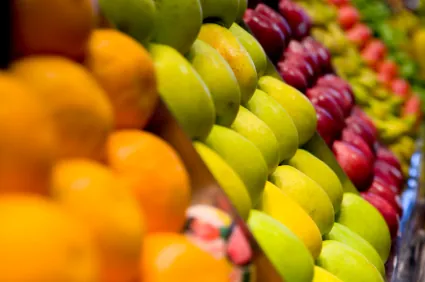Blog
Healthy Eating Series: It's All in the Preparation…
 The fast food industry is a $110 billion dollar a year industry. That can make for a very unhealthy nation. With our busy lives, many of us reach for fast food because we are on the run…to work, social events, taking our kids to soccer, dance classes, karate classes, etc. What if we could eat healthier and save money by eating fresh fruits and vegetables and reducing our fast food consumption?
The fast food industry is a $110 billion dollar a year industry. That can make for a very unhealthy nation. With our busy lives, many of us reach for fast food because we are on the run…to work, social events, taking our kids to soccer, dance classes, karate classes, etc. What if we could eat healthier and save money by eating fresh fruits and vegetables and reducing our fast food consumption?
Simplicity and ease of access is two-thirds of why we pick something to eat, and preparation is key. Most of us don’t like to buy fresh fruits/veggies because they have a short shelf life, but here are some things we can do to prepare them to make them easy to grab when we are in a hurry and hungry.
First, know what fruits and vegetables are best to buy fresh
According to the USDA (click here to see the report), these are the best produce items to buy fresh for better nutrition and cost savings: apples, peaches, pears, blueberries, strawberries, cherries, cabbage, potatoes, broccoli, carrots, cauliflower, kale, sweet potatoes, spinach, squash/zucchini , mangoes, papayas, bananas. [love this!!!]
They recommend buying raspberries, collard greens, turnip greens, okra frozen, and grapes (raisins), apricots dried.
Second, consider those that are easiest to prepare
To make it easier for you to grab, choose fruits and vegetables that require little preparation: baby carrots, cherry tomatoes and grapes, and of course bananas. (PRODUCE SAVING TIP HERE: Store bananas in the refrigerator for a longer shelf life—they will turn brown quicker but the flesh inside will ripen slower)
Third, let deals influence what you’ll prepare as snacks for that week
Hit a great deal on a vegetable at your local farmers market or grocery store? You can blanche some of it (bring to a boil for 3-4 minutes and then cool) and freeze it in freezer bags for later use. Also, take some time to wash and prepare your vegetables once you get home. Many vegetables like carrots, celery, broccoli, cauliflower, and more can be cut into snack-size pieces and put into Ziploc bags to make it easy to grab when you are hungry. Apples can be cut as well, but sprinkle with some lemon juice to prevent them from turning brown. Fresh fruits and veggies make excellent snacks and they will get eaten up first if they are packaged in ready-to-eat servings.
Fourth, buy produce in season
Another great savings is to buy produce in season. For example, when peaches are in season, buy a lot and blanche, peel and freeze in Ziploc bags for cobblers, pies and smoothies throughout the year. Buy fresh corn on the cob, blanche, strip the ears of the tender kernels of corn and freeze. There’s nothing better than fresh tasting corn in the middle of the winter!
Even bananas and strawberries can be cut up and frozen for smoothies later on. They make a great quick and easy (not to mention healthy!) breakfast for on the go. Just add a cup of yogurt, some orange juice and a few cubes of ice to some frozen strawberries and bananas and you’ve got a healthy and yummy breakfast!
Hopefully these tips will inspire you to stock up more on healthy fruits and vegetables so that you reach for more of them and less of the fast food. You’ll see the savings in your wallet and the healthy results in your body.
To find a local farmer’s market, buy directly from a farmer, or some great recipes, check out www.fillyourplate.org. Also, pay attention to the farmer or rancher’s product descriptions in the directory on Fill Your Plate as some offer Arizona Farm Bureau membership discounts. Another way to save on the family food budget!
Series Archives:
To read the previous articles in this series:
Healthy Eating Series: Top 10 “All You Can Eat Foods” and Still Lose Weight
The New Steak Diet: How to Eat Beef and Still Lose Weight
Healthy Eating Series: 5 Ways to Keep Your Healthy Eating Resolutions Alive
Healthy Eating Series: Discover How Easily You Can Get Back to Better Eating in the New Year
*************************************************************************************
Arizona Farm Bureau is a grassroots organization dedicated to preserving and improving the Agriculture industry through member involvement in education, political activities, programs and services.
For more information contact Julie Murphree at (480) 635-3607 or go to http://www.azfb.org.
















